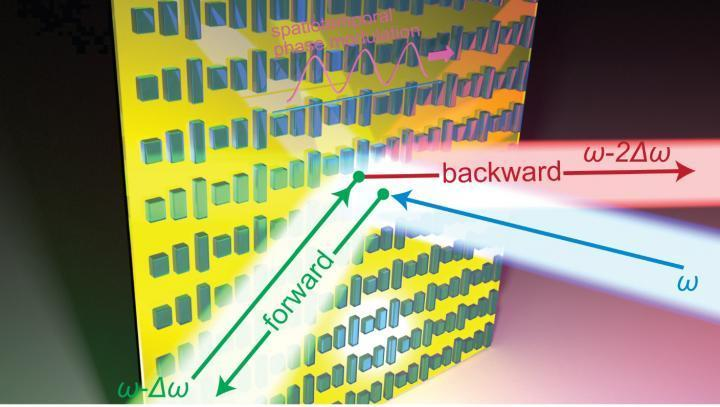Dec 23 2019
Propagation of light is generally reciprocal, which means the path of light moving in one direction is the same as the path of light traveling in the opposite direction. When the reciprocity is broken, the light will propagate in one direction.
 An illustration showing the concept of a space-time phase-modulated metasurface consisting of resonating dielectric nanoantennas operating in reflection mode. A traveling phase modulation in the sinusoidal form is superposed on the designed phase gradient along the horizontal direction. Light impinging on the metasurface with frequency ω is converted to a reflecting beam with frequency ω − Δω due to the parametric process arising from dynamic phase modulation, while the backpropagating beam with frequency ω − Δω is converted to ω − 2Δω instead of ω, resulting in a nonreciprocal effect. Image Credit: Xuexue Guo, Yimin Ding, Yao Duan, and Xingjie Ni.
An illustration showing the concept of a space-time phase-modulated metasurface consisting of resonating dielectric nanoantennas operating in reflection mode. A traveling phase modulation in the sinusoidal form is superposed on the designed phase gradient along the horizontal direction. Light impinging on the metasurface with frequency ω is converted to a reflecting beam with frequency ω − Δω due to the parametric process arising from dynamic phase modulation, while the backpropagating beam with frequency ω − Δω is converted to ω − 2Δω instead of ω, resulting in a nonreciprocal effect. Image Credit: Xuexue Guo, Yimin Ding, Yao Duan, and Xingjie Ni.
Optical components—for instance, circulators and isolators—that support this unidirectional flow of light serve as essential building blocks in various advanced communication and laser systems.
At present, these optical components are nearly exclusively based on the phenomena of the magneto-optic effect and render the devices difficult and huge for integration. It is very difficult to have a magnetic-free path to realize the nonreciprocal propagation of light in various optical applications.
In the recent past, researchers had created a new kind of ultrathin optical metasurface using which phase modulation in time, as well as space, was enforced on the reflected light. This results in different trajectories for the backward and forward propagation of light. With the help of that ultrathin component, nonreciprocal propagation of light in free space was experimentally achieved for the first time.
This is the first optical metasurface with controllable ultrafast time-varying properties that is capable of breaking optical reciprocity without a bulky magnet.
Xingjie Ni, Charles H. Fetter Assistant Professor, Department of Electrical Engineering, Pennsylvania State University
The study results have been recently published in Light: Science and Applications.
The ultrathin optical metasurface includes a silver back-reflector plate that supports silicon nanoantennas shaped like blocks. These nanoantennas have a huge nonlinear Kerr index at near-infrared wavelengths of about 860 nm.
Efficient traveling-wave refractive index modulation was produced on the silicon nanoantennas by using heterodyne interference between a pair of laser lines; these laser lines are proximally spaced in frequency. This approach results in ultrafast fast space-time phase modulation that has a remarkably huge temporal modulation frequency of approximately 2.8 THz.
Such a dynamic modulation method shows excellent flexibility in modifying temporal modulation frequency as well as spatial modulation frequency.
Fully asymmetric reflections in backward and forward propagations of light were experimentally realized with a broad bandwidth of about 5.77 THz within a 150 nm sub-wavelength interaction length.
When reflected by the space-time metasurface, light achieves a momentum shift caused by the spatial phase gradient and also by a frequency shift induced by the temporal modulation. The light displays asymmetric conversions of photons between backward and forward reflections.
Moreover, selective conversions of photons can be freely regulated by creating an unwanted output state to lie in the non-propagative region, which happens to be a forbidden region. This selective photonic conversion can be realized by manipulating the unidirectional momentum transfer offered by the metasurface geometry.
This method shows exceptional flexibility in regulating light in both energy space and momentum. It is expected to offer a novel platform for analyzing fascinating physics that has evolved from time-reliant material characteristics and will present new opportunities for developing magnet-free nonreciprocal devices that can be scaled and integrated.